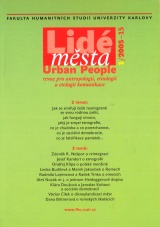Polská národnostní menšina v Praze a problém mladé generace
(Srovnávací studie dospělých osob mladé generace polské komunity v Praze)
DOI:
https://doi.org/10.14712/12128112.3932Abstrakt
The article is divided into two parts. The Polish community in Prague in connection with the whole Polish national minority in the Czech Republic is described in the first part. Size of the community, its legal status and other issues are discussed. The second part is aimed at the problem of a young generation in the Prague Polish community. Final section composes four case studies of young adult (from 21 up to 30 years of age) members of the community. Their national identity is compared with identity elements of the mainstream fraction in the community. The analyses are based on a long term field research. Major institution of the Polish community in Prague is Klub Polski founded in 1887 and re-established after fifty years in 1991. Since it is the only organization regularly gathering Polish national minority in Prague, population in focus of my research is made up of members of Klub Polski or their relatives. Polish community strongly increased with Polish women coming during communist period to fulfil demand for factory labour. Characteristic feature of the Prague community today is thus a high percentage of persons possessing Polish citizenship. This distinguishes the community from the other “traditional” minorities and a rest of the whole Polish minority formed by Czech citizens. Large share of “foreigners” also contributes to their collective identity components. Somewhat autonomous position in the Czech society – “Polish national delegate” role – stems from non-identity-defence approach and high self-confidence of the Polish Prague community, backed with possessing a Polish passport by many. To the collective identity elements of the mainstream group belongs Klub Polski as the identification matrix that often substitutes for disrupted contact with Polish family circles and nation. Among other elements are patriotism and adherence to the Polish state since many members came as Polish citizens and remained so. Catholic religion, chiefly as a cultural background for some activities, and Polish language create the last ones described. Young generation nowadays means usually the second generation of the community. Polish youth has a very high assimilation rate since it comes, with few exceptions, already from nationally mixed families and rarely kept in touch with other children of Polish origin. Their parents mostly did not decide on children’s nationality for they did not see it necessary to preserve Polish identity. In the four case studies particular attention should be paid to differences and similarities between the younger and the older generation. Three of the young have quite similar approach to religion like their parents’ generation for example. Both the young and their parents share value of patriotism. Language is considered as a most significant (and most practical as well) element of national identity in accordance with opinion of their parents’ generation, even though their actual language ability is often lagging behind. The article left some questions to be answered however. To which extent are the intergenerational and interpersonal differences and similarities caused by inherited identity patterns from parents? To which extent it is coincidence caused by encounter of minority society with Czech majority population which influences both parents and their children? These problems as well as many others should be still analysed.
Stahování
Publikováno
Jak citovat
Číslo
Sekce
Licence

Tato práce je licencována pod Mezinárodní licencí Creative Commons Attribution-NonCommercial-NoDerivatives 4.0.


